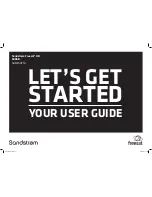
9
www.lairdtech.com
Laird Technologies
CL2510
RF Transceiver
The CL2510 has an internal 256 Byte EEPROM which stores system configuration information. This EEPROM
is loaded at startup and contains the networking and addressing information. The EEPROM can be configured
with AT commands manually or through the Laird Technologies Windows Configuration Utility GUI.
Basic Settings include:
mODE: SERVER/CLIENT
Designate the CL2510 network functionality. In each network, there must be only one Server, all other
CL2510s should be programmed as Clients. The number of Clients is not limited, though they all share
the same bandwidth so available throughput must be considered.
mAx POWER
The maximum transmit power of the CL2510. Reducing the transmit power will reduce the amount of
power the radio needs to transmit (current consumption). Reducing the Max Power will also allow radios
to communicate at very short ranges more effectively. At Full Power the radios should be at least 10ft away
from each other to avoid saturation.
TABLE 4:
POWEr sETTING
CL2510-050 OuTPuT POWEr (mW) TyPICAL
CL2510-100 OuTPuT POWEr (mW) TyPICAL
Full Power
50 mW
125 mW
Half Power
25 mW
50 mW
Quarter Power
12.5 mW
25 mW
Low Power
10 mW
10 mW
*Power levels are approximate and can vary by 20%
RF CHANNEL
The RF Channel is a number that designates the frequency hopping pattern of the CL2510. All CL2510’s hop
over the same frequency range; the RF Channel dictates the order the radios hop through different frequencies.
All radios on the network must have the same RF Channel, unless Auto Channel is enabled on the Clients.
Collocated networks should use different RF Channels to avoid interference.
SYSTEm ID
A number that designates the network identifier. All radios must be on the same System ID unless the Clients
are configured with Auto System ID.
INTERFACE BAUD
This defines the baud rate used for communicating with the CL2510 over the serial interface. The RF Baud is
independent of the Interface Baud Rate. The Default baud rate is 115,200 bps. The Interface Baud rate on the
CL2510 must match the host device baud rate.
TRANSmIT RETRIES
This value represents the maximum number of times a packet will be attempted without a successful
acknowledgement. This number is only used for packets sent in Addressed mode. The default value is 3.
Incrementing this value may increase the reliability of a link.
BROADCAST ATTEmPTS
This value represents the number of times a packet will be sent when using Broadcast Packets.
Unlike Transmit Retries, all Broadcast Attempts will be used every time a packet is sent. The default value is 3.
Increasing this value may increase the reliability of a link.
FULL DUPLEx
The CL2510 reserves two data slots per frequency hop for data transmissions. When Full Duplex is enabled,
Servers will only transmit on the first data slot, thus reserving the second data slot for Clients to transmit.
In networks with a large amount of bidirectional data, Full Duplex will reduce collisions and reduce the need
for additional retries. Full Duplex must be set the same on all radios in the network. Full Duplex only affects the
RF transmission and not to the serial interface.
CL2510
CONFIgURATION
SETTINgS
Содержание ConnexLink CL2510
Страница 28: ......













































